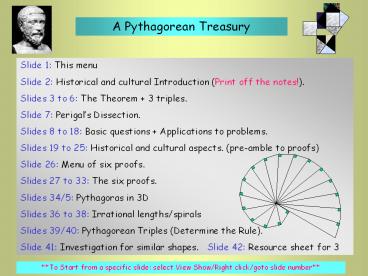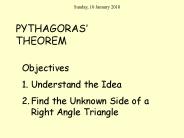Pythagoras - PowerPoint PPT Presentation
Title:
Pythagoras
Description:
The Mesopotamians had a much clearer understanding of Pythagoras Theorem than the Egyptians, although they still could not understand why such sets of triples existed. – PowerPoint PPT presentation
Number of Views:238
Avg rating:3.0/5.0
Title: Pythagoras
1
(No Transcript)
2
Euclid
Pythagoras
3
a2 b2c2
4
(No Transcript)
5
(No Transcript)
6
(No Transcript)
7
(No Transcript)
8
Pythagoras Questions
9
Pythagoras Questions
10
Pythagoras Questions
11
Pythagoras Questions
12
?Perimeter 2(6.54.3) 21.6 cm
13
?Total distance travelled 21.4 16.4 37.7
miles
14
(No Transcript)
15
(No Transcript)
16
An aircraft leaves RAF Waddington (W) and flies
on a bearing of NW for 130 miles and lands at a
another airfield (A). It then takes off and flies
170 miles on a bearing of NE to a Navigation
Beacon (B). From (B) it returns directly to
Waddington. How far has the aircraft flown?
17
Find the distance between two points, a and b
with the given co-ordinates. a(3, 4) and
b(-4, 1)
18
Find the distance between two points, a and b
with the given co-ordinates. a(4, -5) and
b(-5, -1)
19
(No Transcript)
20
(No Transcript)
21
(No Transcript)
22
(No Transcript)
23
(No Transcript)
24
(No Transcript)
25
Proving The Theorem of Pythagoras
There are literally hundreds of different proofs
of Pythagoras Theorem. The original 6th Century
BC proof is lost and the next one is attributed
to Euclid of Alexandria (300 BC) who wrote The
Elements. He proves the Theorem at the end of
book I (I.47) after first proving 46 other
theorems. He used some of these other theorems as
building blocks to establish the proof. This
proof is examined later.
The Chinese may have discovered a proof sometime
during the 1st millennium as a diagram similar to
that shown, appears in a text called Chou pei
suan ching. Although no formal proof was left
behind the diagram clearly indicates that they
had knowledge of 3,4, 5 triangles. Their
reasoning was that the area of the centre square
was the same as the combined area of the 4
triangles the small square contained
within. Area 4 x 6 1 25 (Square on
hypotenuse) of a triangle with sides 3 and 4. So
the third side 5. Some people have suggested
that Pythagoras may have used a similar approach
in his proof. We will now examine a possible
approach to a proof based on this idea shortly.
26
(No Transcript)
27
- We first need to show that the shape in the
middle is a square. - The sides are equal in length since each is the
hypotenuse of congruent triangles.? - The angles are all 90o since xy 900 and angles
on a straight line add to 180o ?
Area of large square (a b)2 a2 2ab
b2 Area of large square is also c2 4 x ½ ab
c2 2ab So ? a2 2ab b2 c2 2ab ? a2
b2 c2 QED
Take 3 identical copies of this right-angled
triangle and arrange like so.
28
- We first need to show that the angle between x
and y is a right angle. - This angle is 90o since xy 90o and angles on a
straight line add to 180o ?
- Area of trapezium
- ½ (a b)(a b) ½ (a2 2ab b2)
- Area of trapezium is also equal to the areas of
the 3 right-angled triangles. - ½ ab ½ ab ½ c2
- So
- ½ (a2 2ab b2) ½ ab ½ ab ½ c2
- a2 2ab b2 2ab c2
- a2 b2 c2 QED
Take 1 identical copy of this right-angled
triangle and arrange like so
29
John Wallis Proof English Mathematician
(1616-1703)
Draw CD perpendicular to AB
Angle BDC is a right angle (angles on a straight
line)
?
?
Angle BCD ? since ? ? 90o 180o (from
large triangle)
Angle ACD ? since ? ? 90o 180o (from
large triangle)
All 3 triangles are similar since they are
equiangular
Comparing corresponding sides in 1 and 2
Comparing corresponding sides in 1 and 3
30
(No Transcript)
31
To Prove that area of square BDEC area of
square ABFG area of square ACHK
- Construct squares on each of the 3 sides (1.46)
- Draw AL through A parallel to BD (1.31)
Proof
- Draw Lines AD and FC
- CA and AG lay on the same straight line (2 right
angles)(1.14) - In triangles ABD and FBC AB FB (sides of the
same small square) - BD BC (sides of the same larger square)
- Also included angles are equal (right angle
common angle ABC) - ?triangles are congruent (SAS) and so are equal
in area (1.4) - Rectangle BDLM 2 x area of triangle ABD (1.41)
- Square ABFG 2 x area of triangle FBC (1.41)
- ?Area of rectangle BDLM Area of square ABFG
Draw lines BK and AE
- BA and AH lay on the same straight line (2 right
angles (1.14) - In triangles ACE and BCK, AC CK (sides of
smaller square) - BC CE (sides of larger square)
- Also included angles are equal (right angle
common angle ACB) - ?triangles are congruent (SAS) and so are equal
in area (1.4) - Rectangle MLCE 2 x area of triangle Ace (1.41)
- Square ACHK 2 area of triangle BCK (1.41)
- ?Area of rectangle MLCE Area of square ACHK
Area of square BDEC area of square ABFG area
of square ACHK. QED
32
- Draw CE perpendicular to BC
- Construct CD equal to CA and join B to D
- Applying Pythagoras Theorem to triangle BCD
- BD2 BC2 DC2 (I.47)
- BD2 a2 b2 (since BC a and DC b)
- BD2 c2 (since a2 b2 c2 given)
- BD c
- Triangles BCD and BCA are congruent by (SSS)
?angle ? is a right angle QED
33
(No Transcript)
34
(a) Find fg first FG2 52 122 FG ?(52
122) FG 13 cm
Use fg to find BG BG2 32 132 FG ?(32
132) FG 13.3 cm
13 cm
(b) Tan FGB 3/13 Angle FGB 13o
35
(a) Find EC first EC2 5.42 9.22 EC ?(5.42
9.22) EC 10.67
10.67
Use fg to find BG BE2 3.12 10.672 BE ?(3.12
10.672) BE 11.1 cm (1 dp)
(b) Tan CEB 3.1/10.67 Angle CEB 16.2o
36
(No Transcript)
37
(No Transcript)
38
(No Transcript)
39
2n2 2n
2n2 2n 1
40
4n2 8n 3
4n2 8n 5
41
(No Transcript)
42
Measure the area of the squares on the side of
the triangles below. What do you conclude?































